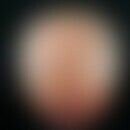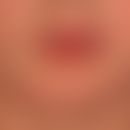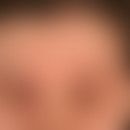Synonym(s)
HistoryThis section has been translated automatically.
Kreibich, 1926; Pinkus, 1957
DefinitionThis section has been translated automatically.
Inflammatory, in rare cases neoplastic "follicular reaction" with adnexotropic lymphoid cell infiltration of the dermis clinically associated with follicular papules, elevated erythema and alopecia. The diagnosis is made histologically by demonstrating intraepithelial "mucin accumulations" in distended sebaceous gland and follicular epithelial cells.
You might also be interested in
ClassificationThis section has been translated automatically.
4 clinically (but not histologically) distinct disease patterns can be distinguished:
- Type I (most common): Acute or subacute localized course associated with circumskripterous alopecia of the terminal hairs in children and young adults. Few 2.0-3.0-4.0 cm, nummular alopecia with skin-colored follicular papules.
- Type II (less common): Chronic, often generalized course in middle-aged to older adults, with disseminated, 0.1 cm, skin-colored, sometimes red follicular papules on the trunk and extremities. May be associated with pruritus.
- Type III (rare) Symptomatic form: Chronic, usually generalized course in middle-aged to older adults (very rarely in children and adolescents), with disseminated, skin-colored or red, 0.1 cm, usually pruritic, follicular papules on the trunk and extremities (rarely face). Considered a precursor stage of follicular cutaneous T-cell lymphoma (see mycosis fungoides folliculotrope below).
- Type IV (rare) Follicular mucinous nevus: A circumscritical form of mucinosis follicularis may also appear as a "follicular mucinous hamartoma" (note: not to be confused with nevus mucinosus a mucinous connective tissue nevus).
EtiopathogenesisThis section has been translated automatically.
Unknown, idiopathic and symptomatic forms.
In some (mostly generalized) cases (type III), mucinosis follicularis is to be regarded as a precursor stage of a (follicular) cutaneous T-cell lymphoma ( = follicular mycosis fungoides) (see also mycosis fungoides, folliculotropic).
ManifestationThis section has been translated automatically.
Children/Youth and Adults (20-30Y/ 50-60Y).
LocalizationThis section has been translated automatically.
Type I: Face and and capillitium
Type II: V.a. trunk and proximal extremities (face rarely involved)
Type III: V.a. trunk and proximal extremities (face rarely involved)
ClinicThis section has been translated automatically.
S. Classification
Clinical picture of mucinosis follicularis is that of a "rubbing skin". It can be clearly distinguished from the completely harmless keratosis follicularis .
Most frequently, larger, mostly blurred plaques appear, which consist of disseminated, but also of grouped, follicular, flat raised, reddened but also skin-colored, symptomless but also clearly itchy (itching can be an expression of an adnexotropic cutaneous T-cell lymphoma) solid keratotic papules. The affected follicles are always hairless. In this respect, a mostly blurred alopecia appears when the capillitium is affected.
Mucinosis follicularis" is generally considered harmless in children and adolescents.
Generalized forms of distribution in adulthood are to be evaluated differently. If these are associated with permanent itching, the suspicion of folliculotropic mycosis fungoides is obvious.
HistologyThis section has been translated automatically.
Vacuolar epithelial cell degeneration with formation of optically empty (mucin is washed out by formalin fixation) or also basophilic clefts and cavities containing granular material in the outer root sheath of the hair follicle or the supraseboglandular portion of the follicle (also in the sebaceous gland lobules).
Usually marked follicular keratosis.
Always evidence of a mostly sparse, but focally condensed, perifollicular lymphoid infiltrate with focal epitheliotropy. In the follicular epithelium there are always degenerative changes, sometimes sections with apoptotic cells.
To differentiate follicular T-cell lymphoma, evidence of T-cell receptor clonality analysis is helpful.
Pattern: Folliculitis infundibular and bulbar, spongiotic .
Differential diagnosisThis section has been translated automatically.
Clinical and histologic:
- Alopecia areata: Important differential diagnosis; no pruritus; follicular papules in alopecia areata very discrete; visible only with lateral illumination. Histologically no evidence of "mucinous follicular degeneration".
- Keratosis pilaris: frequent harmless clinical picture (adolescents, extensor side of the extremities, rubbing iron skin with perifollicular erythema). Improvement or complete healing in adulthood.
- Nevus mucinosus: Congenital or more rarely acquired, in unilateral linear (naevoid) arrangement. Histology identical to mucinosis follicularis.
- Mycosis fungoides, folliculotropic: Probably not a "true" DD, as many authors consider (detectable) folliculotropic MF as a late stage of mucinosis follicularis (type II).
- Urticaria-like mucinosis follicularis. Very rare (entity doubtful), mainly in middle-aged men, head and neck, urticarial follicular papules and plaques with interspersed follicular papules.
- Tinea corporis: Short course; clearly marginalized foci, follicular papules not evenly distributed over the affected area; histological and/or cultural fungal detection.
- Tinea barbae: see above.
- Seborrheic eczema: Important DD; typically localized in the seborrheic zones; no alopecia; histologically, no mucin deposits.
- Keratosis follicularis: Type rusticanus; extensor extremities; onset as early as infancy or adolescence. Clinically usually other signs of keratosis pilaris syndrome ( keratosis follicularis ulerythema ophryogenes, folliculitis ulerythematosa reticulata, folliculitis decalvans).
- Lichen simplex chronicus: Only a few foci, firm, usually scratched papules, often confluent into plaques; very scattered in location; histologically "eczema picture"; no mucin deposits.
- Lichen planus follicularis: Mostly localized to the capillitium; pinhead-sized, follicular erythema (papules), pale to bright red in color, arranged like a ruff around the hair follicle; older burned-out areas show an atrophic scarred, smooth mirror-like surface without erythema or follicular structures. Histologic workup required. Histological signs of interface dermatitis.
TherapyThis section has been translated automatically.
Idiopathic form: In smaller foci, especially with head infestation, try glucocorticoids externally such as 0.1% betamethasone lotio (e.g. Betagalen Lotio, R030 ) or 0.1% triamcinolone cream (e.g. Triamgalen, R259 ). Therapy option also possible with tacrolimus/pimecrolimus. In case of therapy failure or severe manifestation /typeII/type III) systemic glucocorticoids such as prednisone (e.g. Decortin) 40-60 mg/day p.o. with slow reduction.
For clinical types II and III, DADPS (e.g., dapsone-fatol) 100 mg/day p.o., PUVA therapy, or SUP may be used on a trial basis alone or in combination with glucocorticoids.
Treatment success with interferons has been described. The disease shows a spontaneous regression tendency, which makes it difficult to assess the ultimate treatment success of the above methods.
X-rays, which were used in the past, are now completely superseded by the above-mentioned therapeutic methods.
Symptomatic form: Treatment of the underlying disease, if necessary supportive as above.
Progression/forecastThis section has been translated automatically.
Idiopathic mucinosis follicularis:
- Acute form with spontaneous healing after weeks to months without permanent alopecia.
- Chronic form (?): Extension over the entire integument is possible.
Symptomatic mucinosis follicularis (early form of folliculotropic mycosis fungoides): Persistence over several years, transition to clinically and histologically confirmed follicular mycosis fungoides.
Note(s)This section has been translated automatically.
Follicular, perifollicular and sweat gland-associated mucinous processes are increasingly observed in HIV-infected persons and may be attributed to a tendency to "mucinous degenerative reactions" in this clientele (described as eccrine mucinosis, perifollicular mucinosis). Eccrine mucinosis is also observed in folliculotropic T-cell lymphomas.
LiteratureThis section has been translated automatically.
- Brown HA et al (2002) Primary follicular mucinosis: long-term follow-up of patients younger than 40 years with and without clonal T-cell receptor gene rearrangement. J Am Acad Dermatol 47: 856-862
- Buchner SA et al (1991) Follicular mucinosis associated with mycosis fungoides. Dermatologica 183: 66-67
- Daudén E et al (2000) Eccrine ductal mucinosis in a human immunodeficiency virus-positive patient with probable scabies. Br J Dermatol 143:1335-1336.
- Demirkesen C et al (2014) The clinical features and histopathologic patterns of folliculotropic mycosis fungoides in a series of 38 cases. J Cutan Pathol doi: 10.1111/cup.12423
- Garrido MC et al (2013) Primary cutaneous follicle center lymphoma with follicular mucinosis. JAMA Dermatol 150:906-907
- Hagedorn M et al (1986) Treatment of symptomatic mucinosis follicularis in mycosis fungoides with fast electrons. Dermatologist 37: 667-672
- Kluk J et al (2013) Follicular mucinosis treated with topical 0.1% tacrolimus ointment. Clin Exp Dermatol 39: 227-228.
- Muscardin LM et al (2003) Acneiform follicular mucinosis of the head and neck region. Eur J Dermatol 13: 199-202.
- Oiso N et al (2014) Follicular mucinous nevus: a possible new variant of mucinous nevus. J Am Acad Dermatol 71 doi: 10.1016/j.jaad.2014.04.065
- Pinkus H (1957) Centennial Paper. Alopecia mucinosa. Inflammatory plaques with alopecia characterized by root-sheath mucinosis. Arch Dermatol 76: 419-426
Incoming links (17)
Alopecia mucinosa; Alopecia, pinkus; Betamethasone valerate emulsion hydrophilic 0,025/0,05 or 0,1 % (nrf 11.47.); Collagenoma, eruptive; Dermatoses, erythematosquamous; Follicular degeneration mucilaginous; Follicular mucinosis; Folliculotropic mycosis fungoides; Hypotrichosis; Infundibulum folliculitis, disseminated recurrent; ... Show allOutgoing links (24)
Alopecia areata (overview); Alopecia (overview); Betamethasone valerate emulsion hydrophilic 0,025/0,05 or 0,1 % (nrf 11.47.); Dadps; Folliculotropic mycosis fungoides; Glucocorticosteroids; Glucorticosteroids topical; Interferons; Keratosis follicularis acneiformis, Siemens type; Keratosis pilaris; ... Show allDisclaimer
Please ask your physician for a reliable diagnosis. This website is only meant as a reference.
















